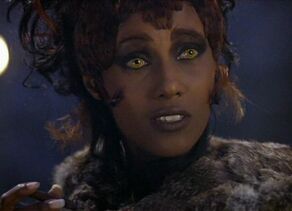--------------------
Welcome back to Character Insight! This week, we profile Lursa and B'Etor from Generations, who come in at number 9 on our best Trek movie villains countdown.


(The dymanic duo of Klingon Kleavage)
Veronica: "How About a Boobie?" clip...Yes indeed, these sisters are a memorable duo that originally starred as antagonists of the two part episode Redemption. But they were likely brought back because they checked the box of one popcorn movie trope, that being...Scott Fletcher: "Boobies!" clip, or more appropriately, in Klingon, Scott Fletcher: "in Klingon, Kap'freah!" clip.
Thankfully, there is more than just Klingon kleavage here, as Generations continues the storyline of the Duras sisters trying to obtain funds and weapons to revolt and take over the Klingon Empire. After Picard failed to be seduced by B'Etor in the episode Redemption and Gowron was put in as chancellor instead of their nephew, the sisters were outcast and that led to a life of crime and rebellion.
These crimes include selling minerals to Bajoran terrorists, rigging a poker tournament in their favor, and finally, the plot to help Dr. Tolian Soran in Generations. Soran had Lursa and B'Etor act as the muscle of the operation, raiding a Romulan outpost for trilithium to make a weapon sufficient to make a star go supernova and move the nexus into the path of Soran.
Quote of the Week: "I hope for your sake you were initiating a mating ritual."
The sisters intend to get the weapon for their own use after Soran's nexus plans. Which of course, successfully lead to Guinan on a carousel, and Picard and Kirk on horses...
"I'm on a horse!"
While the captains are off saving the world from Dr. Soran, the Klingon sisters take on the Enterprise in a long overdue battle. However, crazy acting captain Riker gets the best of Lursa and B'Etor's bird-of-prey and this recurring enemy exits stage left in a glorious space explosion.
They do get the honor of taking down the Enterprise-D though, as another iconic ship from the television shows gets the worst end of a movie plot. ("Brace for Impact!") Lursa and B'Etor make for a nice tie back to the stories in the latter seasons of the TNG series, as well as an interesting parallel to the enemies of Kirk's era. While the return villains are memorable and a strong choice for this role, the plot itself is rather weak and the sisters seem more like eye candy than legitimate muscle in their secondary villain role of this operation.
Still, the tie-back and strong motivations for helping Soren push these sisters into the top 10 of our villain list. Plus, these sisters are eclipsed on this list by only one other role as a female villain, which is a nice change of pace that Star Trek should do more often.
Barbara March and Gwynyth Walsh played Lursa and B'Etor, and you will be happy to know that the TNG Companion confirms that neither has to use chest padding to fill out those interesting Klingon uniforms. Cleavage jokes aside, March pretty must stopped acting after this movie, while Walsh has remained very active in various TV movies and series through this year, including a recurring appearance on NYPD Blue.
Until next time, live long and prosper...




